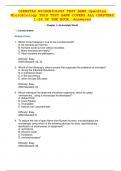-
1. Tentamen (uitwerkingen) - Med-surg ii hesi test bank questions and answers 2022
-
2. Tentamen (uitwerkingen) - 38 free test bank for understanding pathophysiology 5th edition by huether multiple c...
-
3. Tentamen (uitwerkingen) - Test bank pharmacology and the nursing process 9th edition linda lane lilley, shelly ...
-
4. Tentamen (uitwerkingen) - Accumlative nclex test bank nclex: respiratory, neuro, gi, ortho cardiogi, endocrine,...
-
5. Tentamen (uitwerkingen) - Chapter 27: patient safety and quality(testbank) correctly answered
-
6. Tentamen (uitwerkingen) - Hesi test bank-fundamentals completely answered
-
7. Tentamen (uitwerkingen) - Med surg test bank ( red hesi test bank med-surg and other resources) questions and ...
-
8. Tentamen (uitwerkingen) - Maternity hesi test bank (combined red hesi and other sources) answered
-
9. Tentamen (uitwerkingen) - Bates’ guide to physical examination and history taking 13th edition bickley test b...
-
10. Tentamen (uitwerkingen) - Verified *authentic* 2023 hesi rn med surg exam v2 study guide notes test bank & scre...
-
11. Tentamen (uitwerkingen) - c211 maternal child nursing care 6th edition perry test bank
-
12. Tentamen (uitwerkingen) - Med surg hesi exit exam/latest 2023/test bank
-
13. Tentamen (uitwerkingen) - Mental health test bank exam 1 questions and answers correctly updated
-
14. Tentamen (uitwerkingen) - Ati med-surg proctored exam test bank latest 2023 (new) {ngn}with revised and full 10...
-
15. Tentamen (uitwerkingen) - Usareur driver's test bank, with complete verified solution.
-
16. Tentamen (uitwerkingen) - Adult health nursing 6th edition by kockrow – test bank instant download with answe...
-
17. Tentamen (uitwerkingen) - Test bank for canadian fundamentals of nursing, 6th edition| test bank for canadian f...
-
18. Tentamen (uitwerkingen) - Test bank fundamentals of nursing 10th edition potter perry test bank (q&a) all chapt...
-
19. College aantekeningen - 2023-2024 - best solution guaranteed success a+ test bank lutz's nutrition and diet t...
-
20. Tentamen (uitwerkingen) - Test bank lewis's medical-surgical nursing assessment and management of clinical prob...
-
21. Tentamen (uitwerkingen) - Microbiology: an introduction plus mastering microbiology , 13th edition test bank (c...
-
22. Tentamen (uitwerkingen) - Test bank for fundamentals of nursing theory concepts and applications 4th edition by...
-
23. Tentamen (uitwerkingen) - Test bank for clayton’s basic pharmacology for nurses 19th edition by michelle j. w...
-
24. Tentamen (uitwerkingen) - Test bank for davis advantage for maternal-child nursing care 3rd edition by scannell...
-
25. Tentamen (uitwerkingen) - Test bank for maternity and women's health care 12th edition lowdermilk chapter 1-37 ...
-
26. Tentamen (uitwerkingen) - Test bank for fundamentals of nursing 11th edition potter perry chapter 1-50 |newest ...
-
27. Tentamen (uitwerkingen) - Test bank for fundamental concepts and skills for nursing 6th edition by patricia a. ...
-
28. Tentamen (uitwerkingen) - Test bank - medical-surgical nursing: concepts for interprofessional collaborative ca...
-
29. Tentamen (uitwerkingen) - Test bank for microbiology, a systems approach, 6th edition, marjorie kelly cowan, he...
-
30. Tentamen (uitwerkingen) - Test bank public health nursing: population-centered health care in the community 10t...
-
31. Tentamen (uitwerkingen) - Apea 3p test bank questions and correct answers, 149 questions and correct answers, 2...
-
32. Tentamen (uitwerkingen) - Pathophysiology 9th edition mccance test bank updated and verified answers
-
33. Tentamen (uitwerkingen) - Test bank pediatric nursing a care based approch 1st edition tagher knapp
-
34. Tentamen (uitwerkingen) - Test bank for maternal child nursing care 7th edition by shannon e. perry, marilyn j....
-
35. Tentamen (uitwerkingen) - Test bank for maternity and women's healthcare 13th edition all chapters with rationa...
-
36. Tentamen (uitwerkingen) - Test_bank_for_nursing_today_transition_and_trends_10th_edition_by_zerwekh_all_chapter...
-
37. Tentamen (uitwerkingen) - Test bank for williams basic nutrition and diet therapy 16th edition by nix william c...
-
38. Tentamen (uitwerkingen) - Test bank for wongs essential of pediatric nursing 11th edition by marilyn j. hockenb...
-
39. Tentamen (uitwerkingen) - Test bank for timby's introductory medical-surgical nursing, 13th edition (donnelly-m...
-
40. Tentamen (uitwerkingen) - Test bank for williams' essentials of nutrition and diet therapy, 12th edition by ele...
-
41. Tentamen (uitwerkingen) - Socs 185 test bank midterm and final exam newest 2024 actual exam questions and corre...
-
42. Tentamen (uitwerkingen) - Openstax microbiology test bank openstax microbiology this test bank covers all chapt...
-
43. Tentamen (uitwerkingen) - Test bank for leadership roles and management functions in nursing 10th edition by be...
-
44. Tentamen (uitwerkingen) - Test bank for lehninger principles of biochemistry 7th edition by nelson (complete, q...
-
45. Tentamen (uitwerkingen) - Test bank for radiologic science for technologists 12th edition by bushong chapter 1-...
-
46. Tentamen (uitwerkingen) - Test bank for foundations and adult health nursing 7th edition by kim cooper kelly go...
-
Meer zien




